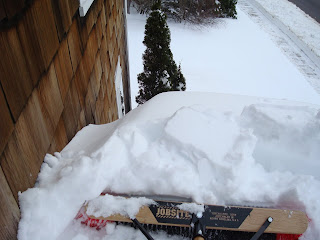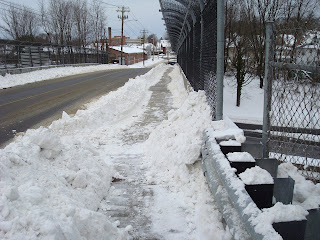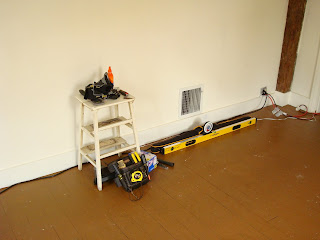We're very green here at the Hawkins house. Partly because I've always been something of an environmentalist, and perhaps also in part because of the centuries-old spirit of self-sufficiency and parsimony that seems to still hover about the place. Face it. In colonial America, people had no choice but to do things in what might be called "green" or "sustainable" ways, simply because there
were no other ways back then.
So this past spring, in accord with those sentiments, I ordered a reel mower from
Lee Valley Tools. A reel mower is essentially the modern, light-weight, high-tech equivalent of those clunky old cast-iron, hand-powered mowers that you might have had the pleasure of using many decades ago.
I have to admit I had my doubts about how effective even a modern version of a hand-powered mower could be. But even if it enabled me to simply reduce, if not eliminate, my use of a gas-powered mower through out the course of the summer, I felt that would be a positive thing. I don't know about you, but I can't stand a pleasant summer evening being ripped to shreds by the sound of a gas mower, no more than I can stand the sound of snow blowers on what should be a peaceful winter's morning.
The mower arrived packed in a cardboard box that was disarmingly small in size:

I brought the box into the mud room, and opened it. The mower also came with a grass catcher that hangs off the back of the mower and handle, but its capacity seemed so small that I never even bothered attaching it. (Though I subsequently found it useful for catching trimmings when the grass isn't very high):

The reel mower and all its parts, organized on the mud room floor:

Assembly was no big deal. The only tools I used were my knife (just to open the packaging) and a spinner with a 7/16" socket. A total of four machine bolts needed to be inserted and nuts tightened, and two clip rings put in place by hand. That was all:

The mower is extremely light - you can easily pick it up by the handle and carry it outside. When not actually cutting grass, the mower can be pulled backwards without the blades being turned. I found that, with a little bit of practice, you can also easily pull the mower around the lawn by flipping it completely over onto its small wheels. That helps to keep the blades out of the way when transporting the mower over hilly terrain:

The mower also stows very easily - it can stand almost completely upright against the wall, and easily fit into a corner of a garage:

Sharpening - What I did discover is that, contrary to claims in the product literature that the mower's blades are sharp enough when delivered from the factory, the blades really needed to be well honed before initial use. I found them just too dull on the first try, and quit my first attempt at cutting grass to hone the blades.
Now, sharpening the blades on this thing involves a rather bizarre process. At least, it seemed bizarre to me at first. But it's actually quite sensible when you understand why you need to do it in this manner. But first, let's go over the sharpening process itself, and then we'll return to why it must done this way.
I ordered the mower with an optional sharpening kit. If you choose to buy this mower, you really need to get the sharpening kit. You can't do with out it. The kit consists of an angled handle that you insert on the pinion that drives the rotating blade assembly off one of the mower's wheels. You have to turn the mower over and place something on the handle to keep it in the position shown below. Then remove a wheel, lift the small gear off the shaft, and carefully insert the handle over the shaft, being careful not to displace the small woodruf key that the gear sits on:

Next, you apply a lapping compound to the outside edges of the rotating blades. The lapping compound is a highly viscous gel that contains some sort of grit suspended in it. Once all the outer edges of the blades are coated, you use the handle to rotate the blade assembly in the
opposite direction from the way it normally turns when cutting grass. The owners manual says to do this for about 5 minutes, and the lapping compound eventually changes color as the gritty particulates get used up:

So why this bizarre process? It turns out that there are actually two sets of opposing blades on the mower: There's the cylindrical, rotating assembly of blades, but then there is also a stationary
cutting blade. The rotating blades apparently catch the blades of grass and force them against the cutting blade, which produces a shearing effect. In this sense, the reel mower is superior to most conventional gas mowers, in which a single cutting blade tears at the grass, rather than cleanly shearing it:

However, the rotating blades and cutting blade are shaped to fit together perfectly in order to work. In fact, the blades actually, and ever so slightly, come into direct contact with one another:

During the sharpening process, the blades are forced to move past each other in a direction opposite to that of cutting. And their mutual contact causes each type of blade (rotating versus stationary) to sharpen the other. Think about it - when you sharpen a knife or tool with a whetstone, you re-shape the cutting edge by moving the blade against the stone opposite to the normal direction of cutting. And that is precisely what is happening here. In fact, the grit in the lapping compound effectively transforms each opposing blade into a whetstone for the other.
So, my main advice to anyone purchasing a reel mower like mine is to keep the blades exceedingly sharp, and furthermore, respect this sharpening process. If you attempt to sharpen these blades in any other manner -- for example, using a stone, or one of those steel sharpening tools that you might use on the single cutting blade of a conventional gas mower -- you will most likely ruin these precisely engineered cutting surfaces, and severely compromise the mower's ability to deliver a clean, shearing cut.
Here's a photo of my side lawn, where the grass was quite tall, and I was able to cut consistently clean rows. The actual performance of the mower is certainly more than acceptable (and higher than I had expected) for a hand-powered tool:

The one thing the reel mower seems to have difficulty with are weeds with large diameter stems. Unlike grass, their tough stems seem just too resilient to get grabbed by the rotating blades, and they often manage to evade the reel mower. Sometimes, you can manage to cut them by making several, full-speed passes over them. But not always. In this case, one must be content with going back to the garage for the weedwacker and making a final pass over the large weeds:

Finally, when finished, it's a good idea to thoroughly clean all the metallic surfaces, and give them a light spray of WD-40. Personally, I like to use an air gun to clean the blades, but a soft synthetic brush or a rag would work just fine. (I happen to love my air tools, by the way, and am always looking for an excuse to use one of them, anyway).

So, my final conclusions are that the modern reel mower is an excellent alternative to a noisy, air-polluting gas-powered mower, most of the time. If you decide to go this route, you might not want to retire the gas mower altogether - in my opinion, you're still going to need it on occasion, especially if you go for extended periods of time not mowing the lawn, and have to deal with very tall, thick, or damp grass.
But the reel mower is more than sufficient for the average situation when you're routinely mowing a reasonably well-kept yard. If you manage to reduce your usage of the gas mower to once or twice or three times a season, that's a big plus for the environment and the general peace and quiet of the neighborhood. And also remember that you're still going to have to rely on that weedwacker for those large stemmed weeds that the reel mower just can't seem to consume. But chances are, you're going to have to use that weedwacker for fine trimming, anyway, so hopefully taking a few extra paces about the yard shouldn't prove too onerous.



































































